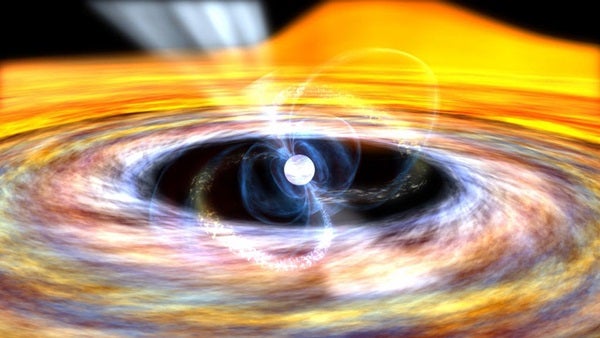The formation of millisecond pulsars is the result of stellar cannibalism where matter flows from a donor star to an accreting pulsar in a binary system. During this process, the pulsar emits X-rays while being spun up to amazingly high rotational speeds with periods of about 1 to 10 milliseconds.
Through numerical calculations on the basis of stellar evolution and accretion torques, Thomas Tauris from the Argelander Institute for Astronomy and the Max Planck Institute for Radio Astronomy in Bonn, Germany, can show that millisecond pulsars lose about half of their rotational energy during the final stages of the mass-transfer process before the pulsar turns on its radio beam. This result is in agreement with current observations, and the findings also explain why radio millisecond pulsars appear to be much older than the white dwarf remnants of their companion stars — and perhaps why no sub-millisecond radio pulsars exist at all.
Millisecond pulsars are strongly magnetized, old neutron stars in binary systems that have been spun up to high rotational frequencies by accumulation of mass and angular momentum from a companion star. Today we know of about 200 such pulsars with spin periods between 1.4 and 10 milliseconds. These are located in both the galactic disk and in globular clusters.
Since the first millisecond pulsar was detected in 1982, it has remained a challenge for theorists to explain their spin periods, magnetic fields, and ages. As an example, there is the “turn-off” problem, i.e., what happens to the spin of the pulsar when the donor star terminates its mass-transfer process?
“We have now, for the first time, combined detailed numerical stellar evolution models with calculations of the braking torque acting on the spinning pulsar,” said Tauris. “The result is that the millisecond pulsars lose about half of their rotational energy in the so-called Roche-lobe decoupling phase.” This phase is describing the termination of the mass transfer in the binary system. Hence, radio-emitting millisecond pulsars should spin slightly slower than their progenitors, X-ray emitting millisecond pulsars that are still accreting material from their donor star. This is exactly what the observational data seem to suggest. Furthermore, these new findings can help explain why some millisecond pulsars appear to have characteristic ages exceeding the age of the universe and perhaps why no sub-millisecond radio pulsars exist.
The key feature of the new results is that it has now been demonstrated how the spinning pulsar is able to break out of its so-called equilibrium spin. At this epoch, the mass-transfer rate decreases, which causes the magnetospheric radius of the pulsar to expand and thereby expel the infalling matter like a propeller. This causes the pulsar to lose additional rotational energy and slow down its spin rate.
“Actually, without a solution to the ‘turn-off’ problem, we would expect the pulsars to even slow down to spin periods of 50 to 100 milliseconds during the Roche-lobe decoupling phase,” said Tauris. “That would be in clear contradiction with observational evidence for the existence of millisecond pulsars.”










